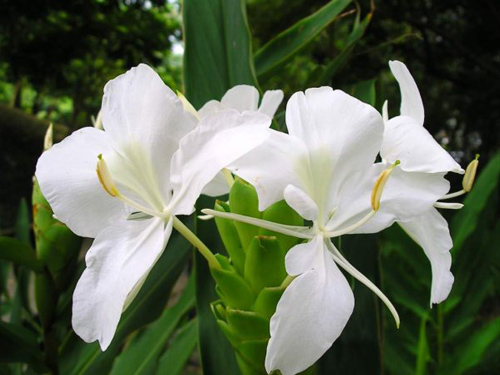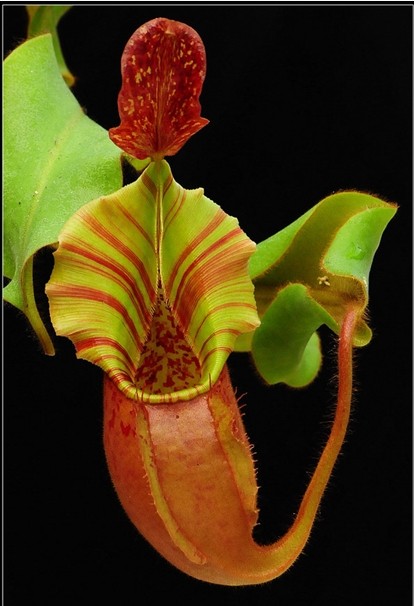Introduction and maintenance of Ginger Flower (Butterfly Lily, Suihua Shannai, Ginger Orchid)
Ginger flower (butterfly lily, Suihua Shannai, ginger orchid)
Scientific name: hedychium coronarium
Aliases: wild ginger, butterfly ginger, paniculata, butterfly, white butterfly, fragrant snow, night cold, turmeric, turmeric
Morphological features: the underground stem is massive and fragrant, shaped like ginger. Leaves long elliptic-lanceolate, sessile, parallel veined, smooth, abaxially with long hairs. Terminal dense spike, protected by large bracts, each inflorescence with 10-15 flowers, white, yellow, red, orange and other colors.
Ecological habits: like light, resistant to half shade, not resistant to cold, like warm and humid climate. It grows well in the slightly acidic and fertile sandy loam, the winter temperature drops below 10 degrees Celsius, the aboveground part withered, and the underground ginger dormancy overwintering.
Florescence: from May to November.
Flower language: trust, nobility and elegance, simplicity.
Garden uses: cut flowers, planted by roadsides, lawns, streams, rockery and pools.
Medicinal efficacy: rhizome and fruit are used as medicine, with the functions of warming the stomach, relieving surface, dispelling wind and dispelling cold, warming menstruation and relieving pain, dispelling cold and so on.

Ginger flower (butterfly lily, Suihua Shannai, ginger orchid)
Scientific name: Hedychium coronarium
Aliases: wild ginger, butterfly ginger, paniculata, butterfly, white butterfly, fragrant snow, night cold, turmeric, turmeric
Morphological features: the underground stem is massive and fragrant, shaped like ginger. Leaves long elliptic-lanceolate, sessile, parallel veined, smooth, abaxially with long hairs. Terminal dense spikes, protected by large bracts, each inflorescence with 10-15 flowers, white, yellow, red, orange and other colors.
Ecological habits: like light, resistant to half shade, not resistant to cold, like warm and humid climate. It grows well in the slightly acidic and fertile sandy loam, the winter temperature drops below 10 ℃, the aboveground part withered, and the underground ginger dormancy overwintering.
Florescence: from May to November.
Flower language: trust, nobility and elegance, simplicity.
Garden uses: cut flowers, planted by roadsides, lawns, streams, rockery and pools.
Medicinal efficacy: rhizome and fruit are used as medicine, with the functions of warming the stomach, relieving surface, dispelling wind and dispelling cold, warming menstruation and relieving pain, dispelling cold and so on.
- Prev

The knack of potted pitcher plants
Pitcher plant is also known as piggy cage and cordyceps. Sex likes a warm, moist, well-ventilated semi-overcast environment. Not resistant to cold, afraid of dryness and direct light. The suitable temperature for growth is 20-30 degrees Celsius, and the indoor temperature should not be lower than 16 degrees Celsius in winter. Suitable for loose, fertile, well-drained slightly acidic soil
- Next

Introduction and cultivation of Prunus mume (throat grass, white pearl grass, copper money grass)
Plum (throat grass, white pearl grass, copper money grass) scientific name: androsaceumbellata family genus: Primulaceae morphological characteristics: perennial herbs, plant body is fine pilose, plant height 1530 cm. Leaves cordate, margin dentate. The flower is upright.
Related
- Fuxing push coffee new agricultural production and marketing class: lack of small-scale processing plants
- Jujube rice field leisure farm deep ploughing Yilan for five years to create a space for organic food and play
- Nongyu Farm-A trial of organic papaya for brave women with advanced technology
- Four points for attention in the prevention and control of diseases and insect pests of edible fungi
- How to add nutrient solution to Edible Fungi
- Is there any good way to control edible fungus mites?
- Open Inoculation Technology of Edible Fungi
- Is there any clever way to use fertilizer for edible fungus in winter?
- What agents are used to kill the pathogens of edible fungi in the mushroom shed?
- Rapid drying of Edible Fungi

